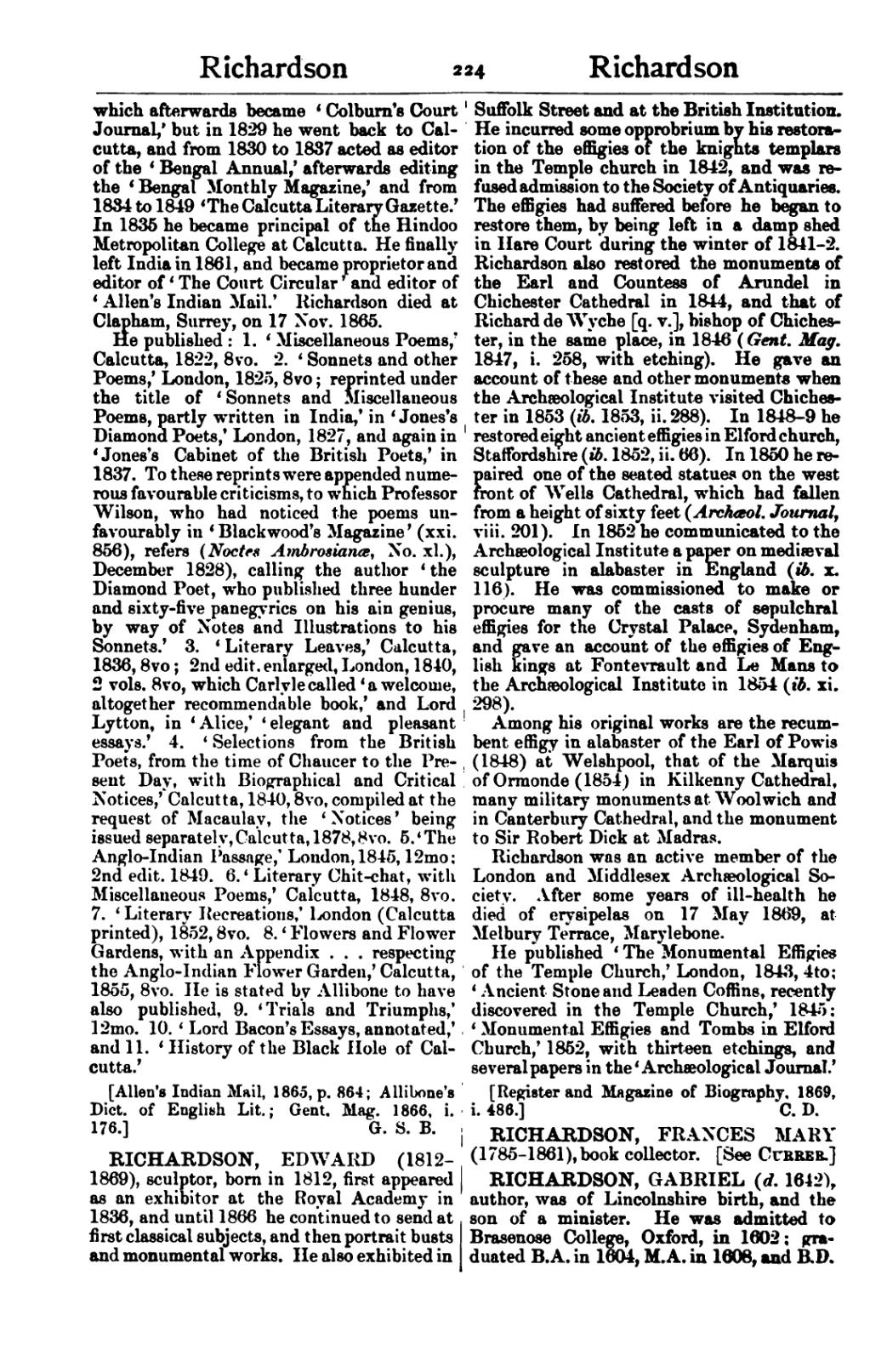which afterwards became ‘Colburn's Court Journal,’ but in 1829 he went back to Calcutta, and from 1830 to 1837 acted as editor of the ‘Bengal Annual,’ afterwards editing the ‘Calcutta Monthly Journal,’ and from 1834 to 1849 ‘The Calcutta Literary Gazette.’ In 1836 he became professor of English literature of the Hindoo College at Calcutta, largely on Macaulay's recommendation, and in 1839 he was promoted to the newly-created post of principal of the college, while retaining his professorship. He finally left India in 1861, and became proprietor and editor of ‘The Court Circular’ and editor of ‘Allen's Indian Mail.’ Richardson died at Clapham, Surrey, on 17 Nov. 1865.
He published: 1. ‘Miscellaneous Poems,’ Calcutta, 1822, 8vo. 2. ‘Sonnets and other Poems,’ London, 1825, 8vo; reprinted under the title of ‘Sonnets and Miscellaneous Poems, partly written in India,’ in ‘Jones's Diamond Poets,’ London, 1827, and again in ‘Jones's Cabinet of the British Poets,’ in 1837. To these reprints were appended numerous favourable criticisms, to which Professor Wilson, who had noticed the poems unfavourably in ‘Blackwood's Magazine’ (xxi. 856), refers (Noctes Ambrosianæ, No. xl., December 1828), calling the author ‘the Diamond Poet, who published three hunder and sixty-five panegyrics on his ain genius, by way of Notes and Illustrations to his Sonnets.’ 3. ‘Literary Leaves,’ Calcutta, 1836, 8vo; 2nd edit. enlarged, London, 1840, 2 vols. 8vo, which Carlyle called ‘a welcome, altogether recommendable book,’ and Lord Lytton, in ‘Alice,’ ‘elegant and pleasant essays.’ 4. ‘Selections from the British Poets, from the time of Chaucer to the Present Day, with Biographical and Critical Notices,’ Calcutta, 1840, 8vo, compiled at the request of Macaulay, the ‘Notices’ being issued separately, Calcutta, 1878, 8vo. 5. ‘The Anglo-Indian Passage,’ London, 1845, 12mo; 2nd edit. 1849. 6. ‘Literary Chit-chat, with Miscellaneous Poems,’ Calcutta, 1848, 8vo. 7. ‘Literary Recreations,’ London (Calcutta printed), 1852, 8vo. 8. ‘Flowers and Flower Gardens, with an Appendix … respecting the Anglo-Indian Flower Garden,’ Calcutta, 1855, 8vo. He is stated by Allibone to have also published 9. ‘Trials and Triumphs,’ 12mo. 10. ‘Lord Bacon's Essays, annotated,’and 11. ‘History of the Black Hole of Calcutta.’
[Allen's Indian Mail, 1865, p. 864; Allibone's Dict. of English Lit.; Gent. Mag. 1866, i. 176.]
RICHARDSON, EDWARD (1812–1869), sculptor, born in 1812, first appeared as an exhibitor at the Royal Academy in 1836, and until 1866 he continued to send at first classical subjects, and then portrait busts and monumental works. He also exhibited in Suffolk Street and at the British Institution. He incurred some opprobrium by his restoration of the effigies of the knights templars in the Temple church in 1842, and was refused admission to the Society of Antiquaries. The effigies had suffered before he began to restore them, by being left in a damp shed in Hare Court during the winter of 1841–2. Richardson also restored the monuments of the Earl and Countess of Arundel in Chichester Cathedral in 1844, and that of Richard de Wyche [q. v.], bishop of Chichester, in the same place, in 1846 (Gent. Mag. 1847, i. 258, with etching). He gave an account of these and other monuments when the Archæological Institute visited Chichester in 1853 (ib. 1853, ii. 288). In 1848–9 he restored eight ancient effigies in Elford church, Staffordshire (ib. 1852, ii. 66). In 1850 he repaired one of the seated statues on the west front of Wells Cathedral, which had fallen from a height of sixty feet (Archæol. Journal, viii. 201). In 1852 he communicated to the Archæological Institute a paper on mediæval sculpture in alabaster in England (ib. x. 116). He was commissioned to make or procure many of the casts of sepulchral effigies for the Crystal Palace, Sydenham, and gave an account of the effigies of English kings at Fontevrault and Le Mans to the Archæological Institute in 1854 (ib. xi. 298).
Among his original works are the recumbent effigy in alabaster of the Earl of Powis (1848) at Welshpool, that of the Marquis of Ormonde (1854) in Kilkenny Cathedral, many military monuments at Woolwich and in Canterbury Cathedral, and the monument to Sir Robert Dick at Madras.
Richardson was an active member of the London and Middlesex Archæological Society. After some years of ill-health he died of erysipelas on 17 May 1869, at Melbury Terrace, Marylebone.
He published ‘The Monumental Effigies of the Temple Church,’ London, 1843, 4to; ‘Ancient Stone and Leaden Coffins, recently discovered in the Temple Church,’ 1845; ‘Monumental Effigies and Tombs in Elford Church,’ 1852, with thirteen etchings, and several papers in the ‘Archæological Journal.’
[Register and Magazine of Biography, 1869, i. 486.]
RICHARDSON, FRANCES MARY (1785–1861), book collector. [See Currer.]
RICHARDSON, GABRIEL (d. 1642), author, was of Lincolnshire birth, and the son of a minister. He was admitted to Brasenose College, Oxford, in 1602; graduated B.A. in 1604, M.A. in 1608, and B.D.
